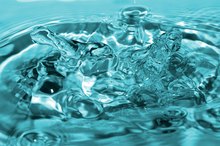The Effect of Algae on the pH
There are a variety of algae species occurring in different habitats in the world such as fresh water, marine, desert sand and snow. These photosynthetic organisms are vital since aquatic animals feed on the organic matter they produce. Algae also take up excess nutrients such as phosphate, ammonia and nitrate, which can intoxicate marine life from the water. Algae grow fast in warm temperatures and water and when there is a lot of organic material in the water. However, algae blooms may result in mortality of aquatic life, since they affect the PH of the water.
Optimal Conditions for Algae Growth
Most algae thrive and multiply in water with high pH levels ranging between seven and nine. The optimum pH for most algae species is 8.2 to 8.7. Neutral or lower water pH decreases the growth of algae. Algae, like other plants, utilize light to photosynthesize food for growth. Low temperatures slow algae growth, which blooms and multiplies in warm temperatures of approximately 16 to 27 degrees.
- Most algae thrive and multiply in water with high pH levels ranging between seven and nine.
- Low temperatures slow algae growth, which blooms and multiplies in warm temperatures of approximately 16 to 27 degrees.
PH Effects During the Day
The Advantages of Rainfall
Learn More
During the day, photosynthesis takes place, due to the presence of sunlight. Algae draw carbon dioxide from the water to utilize during photosynthesis, promoting cell growth. Removal of carbon dioxide from the water raises the pH levels, as a result of the reduction in carbonate and bicarbonate levels of water, since they are used to replenish the lost carbon dioxide. Depletion of inorganic carbon from water by algae results in high pH levels, as evidenced by the rise in pH levels of natural waters, which can go up to 10 or beyond in the presence of algae. The rise of water pH also causes ionization of ammonia which is detrimental to aquatic life.
- During the day, photosynthesis takes place, due to the presence of sunlight.
- Removal of carbon dioxide from the water raises the pH levels, as a result of the reduction in carbonate and bicarbonate levels of water, since they are used to replenish the lost carbon dioxide.
PH Effects at Night
At night, no photosynthesis takes place, so algae stops taking in carbon dioxide from water and goes into a respiratory stage 1. During this respiratory stage, algae consume oxygen that was produced during photosynthesis and release carbon dioxide into the water 1. This increased production of carbon dioxide decreases the pH levels in the water at night. Therefore, it is essential to control the algae growth, since they compete for oxygen with other aquatic animals at night.
Implications of Algae Effectson pH
The Advantages & Disadvantages of Carbon Dioxide
Learn More
As stated above, algae cause pH fluctuations in water during the day and at night 1. These pH fluctuations cause stress in aquatic animals and might lead to death or interfere with growth. Large numbers of algae are likely to cause more pH fluctuations, thus it is important to control algae blooms. Algae growth can be minimized by planting water plants such as water lilies, which will be competing for nutrients and light with the algae.
- As stated above, algae cause pH fluctuations in water during the day and at night 1.
- Algae growth can be minimized by planting water plants such as water lilies, which will be competing for nutrients and light with the algae.
Related Articles
References
Writer Bio
Jane Doucet has been writing professionally since 2003. Her articles have been published with the "Canadian Living," "Gardening Life," "Homemakers," "Reader's Digest" and "Halifax Magazine," among other publications. Doucet holds a Master of Arts in journalism from University of King's College, Halifax.









